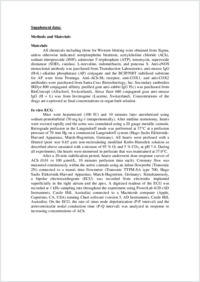Mutation of the circadian clock gene Per2 alters vascular endothelial function
- Viswambharan, Hema Department of Medicine, Division of Physiology, University of Fribourg, Switzerland
- Carvas, João Miguel Department of Medicine, Division of Physiology, University of Fribourg, Switzerland
- Antic, Vladan Department of Medicine, Division of Physiology, University of Fribourg, Switzerland
- Marecic, Ana Department of Medicine, Division of Physiology, University of Fribourg, Switzerland
- Jud, Corinne Department of Medicine, Division of Biochemistry, University of Fribourg, Switzerland
- Zaugg, Christian E. Department of Research, University Hospital Basel, Switzerland
- Ming, Xiu-Fen Department of Medicine, Division of Physiology, University of Fribourg, Switzerland
- Montani, Jean-Pierre Department of Medicine, Division of Physiology, University of Fribourg, Switzerland
- Albrecht, Urs Department of Medicine, Division of Biochemistry, University of Fribourg, Switzerland
- Yang, Zhihong Department of Medicine, Division of Physiology, University of Fribourg, Switzerland
-
02.04.2007
Published in:
- Circulation. - 2007, vol. 115, p. 2188-2195
English
Background— The circadian clock regulates biological processes including cardiovascular function and metabolism. In the present study, we investigated the role of the circadian clock gene Period2 (Per2) in endothelial function in a mouse model. Methods and Results— Compared with the wild-type littermates, mice with Per2 mutation exhibited impaired endothelium-dependent relaxations to acetylcholine in aortic rings suspended in organ chambers. During transition from the inactive to active phase, this response was further increased in the wild-type mice but further decreased in the Per2 mutants. The endothelial dysfunction in the Per2 mutants was also observed with ionomycin, which was improved by the cyclooxygenase inhibitor indomethacin. No changes in the expression of endothelial acetylcholine-M₃ receptor or endothelial nitric oxide synthase protein but increased cyclooxygenase-1 (not cyclooxygenase-2) protein levels were observed in the aortas of the Per2 mutants. Compared with Per2 mutants, a greater endothelium-dependent relaxation to ATP was observed in the wild-type mice, which was reduced by indomethacin. In quiescent aortic rings, ATP caused greater endothelium-dependent contractions in the Per2 mutants than in the wild-type mice, contractions that were abolished by indomethacin. The endothelial dysfunction in the Per2 mutant mice is not associated with hypertension or dyslipidemia. Conclusions— Mutation in the Per2 gene in mice is associated with aortic endothelial dysfunction involving decreased production of NO and vasodilatory prostaglandin(s) and increased release of cyclooxygenase-1–derived vasoconstrictor(s). The results suggest an important role of the Per2 gene in maintenance of normal cardiovascular functions.
- Faculty
- Faculté des sciences et de médecine
- Department
- Département de Biologie, Département de Médecine
- Language
-
- English
- Classification
- Biological sciences
- License
-
License undefined
- Identifiers
-
- RERO DOC 8187
- DOI 10.1161/CIRCULATIONAHA.106.653303
- Persistent URL
- https://folia.unifr.ch/unifr/documents/300364
Other files
Statistics
Document views: 151
File downloads:
- pdf: 260
- Supplementary material: 147

